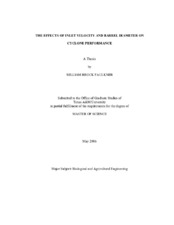| dc.description.abstract | Cyclone separators are widely used in agricultural processing industries as air
pollution abatement devices. The performance of cyclones is a function of the geometry
of the cyclone, operating parameters, and the particle size distribution (PSD) of the
entrained aerosol. Multiple models have been proposed to predict the performance of
cyclones given different geometric proportions, but many of these models do not
quantify changes in performance with changes in inlet velocity or cyclone diameter
given fixed geometric proportions.
The Texas A&M Cyclone Design (TCD) method is a simple method for
designing cyclones based on an inlet design velocity. The TCD method specifies “ideal”
inlet velocities of 975 ± 120 m/min (3200 ± 400 fpm) and 914 ± 120 m/min (3000 ± 400
fpm) for 1D3D and 2D2D cyclones, respectively. However, there is evidence that
higher dust collection efficiencies may be obtained from cyclones using different inlet
velocities than those specified as the “ideal” velocity. Furthermore, the TCD method
assumes that cyclone performance is independent of cyclone diameter.
The present research demonstrates that, for large particles, the collection
efficiency of 15.24 cm (six inch) diameter 1D3D and 2D2D cyclones is similar for inlet
velocities from 10.16 standard m/s (2000 fpm) up to the design velocity, with significantly lower pressure drop at lower inlet velocities, resulting in lower energy
requirements. However, the performance of cyclones is a function of cyclone diameter.
Using similar operating parameters, the collection efficiency of a 60.96 cm (24 inch)
diameter 1D3D cyclone was significantly lower (α = 0.05) than that of a 15.24 and a
30.48 cm (6 and 12 inch) diameter cyclone, and the collection efficiency of a 91.44 cm
(36 inch) cyclone was significantly lower (α = 0.05) than that of a 60.96 cm (24 inch)
diameter cyclone. The results of this research suggests the need for a new mathematical
model to predict the performance of cyclones. | en |


